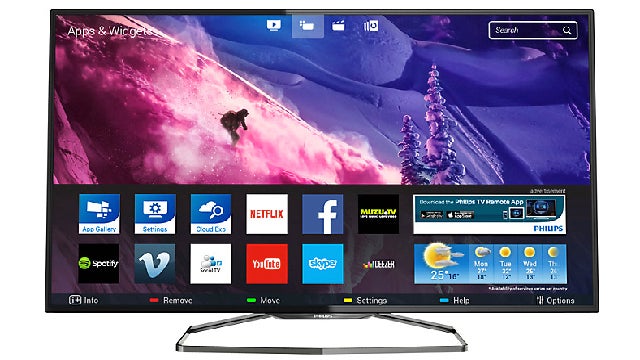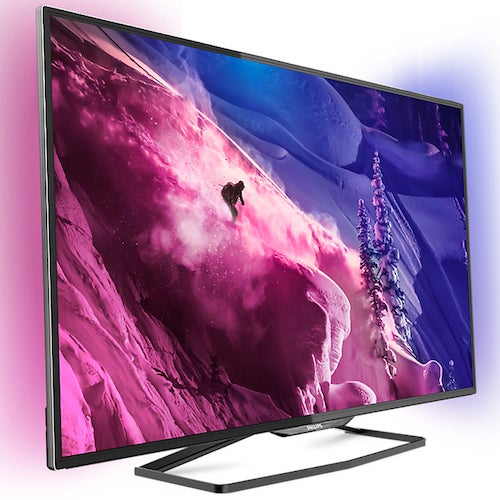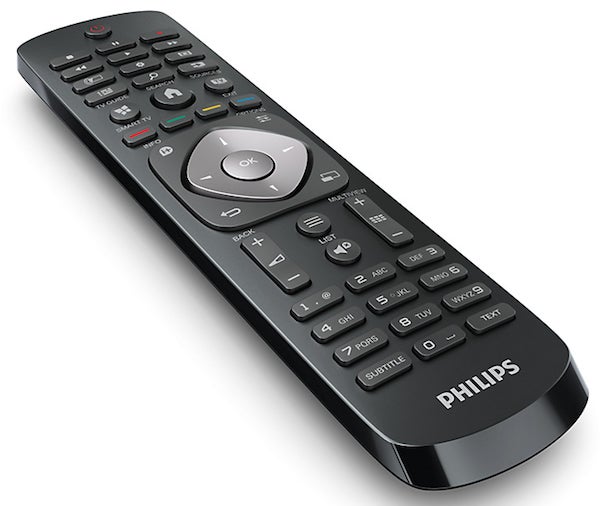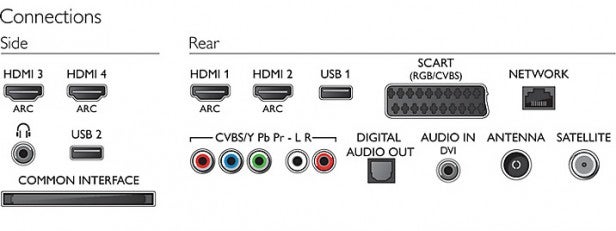Philips 48PFS6909 Review
Philips 48PFS6909
Ambilight and great picture quality combine to make a top mid-range TV

Sections
- Page 1 Philips 48PFS6909 Review
- Page 2 Picture Quality Review
- Page 3 3D, Sound and Verdict Review
Verdict
Key Specifications
- Review Price: £699.00
- 48-inch TV with direct LED lighting
- Full HD native resolution
- Smart TV platform with Netflix and BBC iPlayer
- Active 3D playback (two pairs of glasses included)
- Two-sided Ambilight technology
What is the Philips 48PFS6909?
The 48PFS6909 is an affordable 48-inch Full HD TV with 3D and Smart TV features, although it’s not one of Philips’ Android TVs. Roughly in the middle of Philips’ current UK range, it also boasts the brand’s trademark Ambilight technology.
SEE ALSO: Best TVs Round-up
Philips 48PFS6909 – Design
Philips has turned out some of the best-dressed TVs in town in recent years, and the 48PFS6909 continues this theme with its slender glossy black frame, trim rear and distinctively angular, open-framed stand. It feels a little flimsier than it looks, but this isn’t a big deal unless you’re in the habit of stroking your TV regularly.
Tucked away on the set’s rear side is a healthy roster of connections for a mid-range TV. Four HDMIs get the ball rolling, while multimedia playback is delivered via a pair of USBs and both Wi-Fi and Ethernet connections. The USBs also provide the option of recording from the built-in Freeview HD Tuners to an external USB HDD.

Some of Philips’ current TV range have been built around IPS panel types, with fairly unhappy results. So it’s a relief to find the 48PFS6909 using a VA-type panel instead – a fact revealed by its active 3D system, as IPS screens go the passive route. It ships with two pairs of active-shutter 3D glasses.
The 48PFS6909 uses a direct LED lighting system, where the LEDs are positioned directly behind the screen. This can lead to better contrast than you get with typical edge LED TVs – though the 48PFS6909’s backlighting isn’t accompanied by a true local dimming engine where separate zones of the lights can have their luminance adjusted individually. Instead there’s something called ‘Micro Dimming Pro’, which breaks the image down into small segments for more accurate analysis and a degree of localised contrast manipulation.
When it comes to handling motion, the 48PFS6909 is a native 100Hz TV, but boosts this figure to 600Hz Perfect Motion Rate (PMR) via backlight scanning and Philips’ HD Natural Motion frame interpolation processing.
The processing engine inside the 48PFS6909 is Philips’ Pixel Precise HD system, powered by a dual-core processor. This isn’t necessarily great news given that Pixel Precise HD is a couple of generations old – we’re on to Perfect Pixel HD and 4K now – and some of the 48PFS6909’s rivals now use quad-core engines. But Philips has a strong pedigree of making its processing power count more than most, so hopefully this will prove true of the 48PFS6909, too.
The 48PFS6909’s dual-core processing also powers the set’s Smart TV features. We’ve covered these in a previous dedicated feature, but briefly the system is currently a B-lister on account of its ineffective content-finding features – its recommendations engine, for instance, is far worse than that of some rivals – and some key missing streaming services, such as the ITV Player, 4oD, Demand 5 and Amazon Prime.
The set can stream multimedia via DLNA from compatible devices, share content on your phone or tablet with the TV via the Philips MyRemote app, and mirror your smart device’s screen on the TV via MiraCast. It also has a Cloud TV feature that lets you access material stored in your Dropbox account, and client and server support to connect wirelessly to other TVs for sharing broadcasts and recordings between them without the need for multiple broadcast service subscriptions.
Philips 48PFS6909 – Setup
There’s a bit of work to do if you want to get the best out of the 48PFS6909. For starters we strongly recommend that you only run the HD Natural Motion system on its lowest setting to stop the picture from starting to look overly processed. Also make sure the set’s noise reduction is off or set to low, and we’d suggest that you set the TV’s Contrast Mode to Standard to give pictures a slight contrast boost without causing brightness instability.
We’d also treat the provided Super Resolution sharpness booster with suspicion, as it tends to over-stress edges and cause a rather gritty look with all but the most pristine sources – and if those sources are so pristine, they arguably don’t need a sharpness boost anyway!

Also worth tinkering with is the Ambilight setting, as we felt it was at its most effective at immersing you in the action when used on a gentle setting with a reduced brightness level.
One final surprising discovery is that the 48PFS6909’s ‘Light Sensor’ mode proves cleverer than most, adjusting the qualities of the image in response to the amount of light in the room without leaving the results looking unstable, too flat or too aggressive.
Aside from being a bit sluggish, the 48PFS6909’s initial setup menus are reasonably straightforward and well thought through, and include both a demo of the TV’s abilities and a picture setup wizard.
How we test televisions
We test every TV we review thoroughly over an extended period of time. We use industry standard tests to compare features properly. We’ll always tell you what we find. We never, ever, accept money to review a product.

